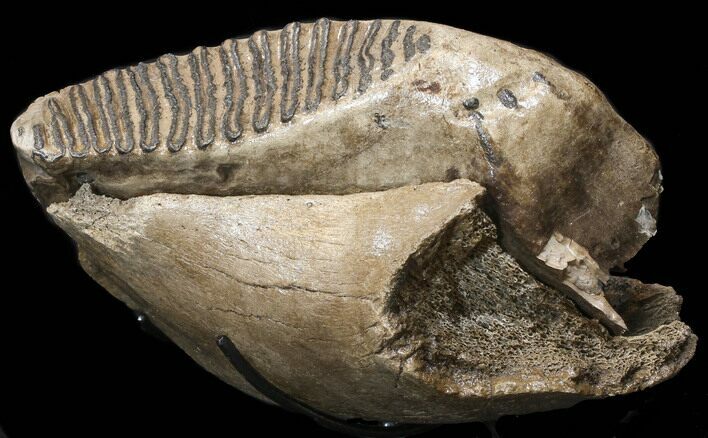This Specimen has been sold.
Partial Mammoth Lower Jaw With Huge Molar - North Sea
This is a partial lower jaw of a Woolly Mammoth (Mammuthus primigenius) with a gigantic M3 molar still in place. It comes from the Pleistocene aged (20-50k years ago) deposits of the North Sea, off the coast of the Netherlands. The jaw section is 17.7 inches long and the molar itself is 11.2" long. The piece comes with a custom metal stand to display it.
These pleistocene fossils are dredged up by fishing trawlers in the the North Sea between Britain and Denmark. Fishermen routinely find mammoth teeth and many ice aged fossils in their nets and given the chance that a fossil is accidentally gathered in a net is slim the sea floor is probably littered with the remains of millions of animals. The cold temperatures and low oxygen environment of the North Sea has aided in the preservation of these teeth and bones.
While these fossils have been pulled up in nets for more than a century, they were frequently discarded. It wasn't until the past two decades that this material has begun to be systematically collected and studied. By recording the locations of their finds and allowing scientists to make observations before the more common material is made available, much has been learned about the fauna that once roamed the land that now lies 30 to 150 feet below the North Sea waters.
You can read more information about this at the following link.
http://www.independent.co.uk/news/science/the-watery-grave-of-europes-monsters-1744973.html
These pleistocene fossils are dredged up by fishing trawlers in the the North Sea between Britain and Denmark. Fishermen routinely find mammoth teeth and many ice aged fossils in their nets and given the chance that a fossil is accidentally gathered in a net is slim the sea floor is probably littered with the remains of millions of animals. The cold temperatures and low oxygen environment of the North Sea has aided in the preservation of these teeth and bones.
While these fossils have been pulled up in nets for more than a century, they were frequently discarded. It wasn't until the past two decades that this material has begun to be systematically collected and studied. By recording the locations of their finds and allowing scientists to make observations before the more common material is made available, much has been learned about the fauna that once roamed the land that now lies 30 to 150 feet below the North Sea waters.
You can read more information about this at the following link.
http://www.independent.co.uk/news/science/the-watery-grave-of-europes-monsters-1744973.html
SPECIES
Mammuthus primigenius
LOCATION
North Sea Deposits
SIZE
17.7" long x 9.5" tall, Molar 11.2" long
CATEGORY
SUB CATEGORY
ITEM
#35699
We guarantee the authenticity of all of our specimens.
 Reviews
Reviews
















